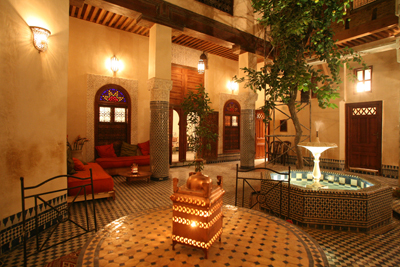After a very quiet time in the Moroccan real estate market, things look set to change. One early indicator is that major media players are giving space to stories about buying property in Morocco. From airline inflight magazines to the lofty heights of the New York Times, journalists are pointing to Morocco as a good place to invest.
What is particularly interesting is the attention is not on Marrakech, but Fez. Although Fez is the spiritual and cultural heart of the country, Marrakech has always been the 'party town' with a louche reputation akin to that of Tangier, and been the choice particularly of French investors. While Casablanca is the commercial heart, it has not attracted attention from British, American and French home buyers. So, what is happening in Fez, and why the attention?
The first unusual thing about the Fez market is that it is actually two different markets - the World Heritage listed Medina and the Ville Nouvelle or New City. The Ville Nouvelle is often the choice of Moroccans and those with businesses there, but for foreigners the charm of the Medina, being car-free, with its medieval houses and labyrinthine alley ways, is the key point.
 |
| A riad for sale in Fez - in perfect condition |
Then, having chosen the Medina, there is another choice to be made; a riad or a dar. A riad is normally larger and has an open central courtyard with trees, a fountain or garden. A dar is smaller, with a central courtyard that can often be closed over against inclement weather. Dars do not have a central garden or fountain although they may often have a wall fountain.
Another consideration is the age of the house. David Amster, in his fine website A House in Fez.com has this to say: In terms of age, you need to decide whether you want a older house, generally 17th to 19th century, or a "neotraditional" house from the early 20th century. Older houses are more interesting, but generally need more restoration and are deeper in the medina. Note too that the age of a medina house is often hard to determine. There is often a date on the plaster above one of the main salon doors, but this is the date in the Islamic calendar of when that plaster was completed and generally has nothing to do with when the house was built. It's also normal for doors, beams, carved plaster, and zellij to be replaced every one to two hundred years, which means that a seven-hundred-year-old house sometimes looks like it's 19th century.
 |
| For sale a potential maison d'hôtes |
Quoted in a recent New York Times article, Cédric Elsener, the owner of Maroc Immobilier Capital, says, “The Medina is really bewitching. It has a weird effect on you. Either you love it or you hate it — nothing in between.” According to Frédéric Sola, owner of Fez Real Estate, a company that sells and renovates riads in the Medina, “Time stopped about five centuries ago. What you see in the Medina, you don’t see anywhere else in the world.”
Also quoted in the New York times is Tim McTighe, a partner of Fes Properties, which sells, restores and manages properties in the Medina. Like others he reflects that the property market has been slow since 2008. “I’d say the glory days were between 2004 and 2007,” said Mr. McTighe. He and other brokers attribute that primarily to the global economic downturn, though they acknowledge that the regional political turmoil of the Arab Spring hasn’t helped. “Unfortunately some people put Morocco in the same basket” as Libya, Egypt, Tunisia, and other strife-torn countries in the area, said Mr. McTighe, suggesting that possible investors might be watching and waiting. “But Morocco is a very peaceful country, night and day with a country like Libya.”
Fred Sola points out that despite the sluggish market prices have not fallen sharply, because there are fewer properties on the market. “There have been some good bargains from foreigners who had to resell riads quickly,” said Mr. Sola. Mr. Elsener said it was a good time to buy, especially given improvements in Fez’s accessibility. “There are more direct flights to Europe,” he said, “and they are working to double the size of capacity at the airport. We also have a new highway that opened last June — from Fez you can drive to the Mediterranean in two and a half hours.”
One changing demographic is the nationality of those purchasing properties. For a long time the major buyers were French, but with the increase in budget airline flights to Morocco, other nationalities are catching up. Also present in the market are Belgians, Italians, Americans, Britons and several Australian or New Zealanders. While a majority of investors are buying in order to set up a guesthouse, a small number are buying private residences.
 |
| Traditional restoration takes time and money |
The initial purchase of a house can be a relatively simple procedure, however, the cost of restoration needs to be factored in. In general terms, restoration is likely to cost two to three times the purchase price, depending on the structural condition of the building. Those who have been through the renovation process will be quick to advise that it is best to be on site for any major work as communicating day to day decisions by email or telephone is far from efficient. For this reason, a growing number of buyers are looking at properties where a majority of the restoration work is already completed.
Further reading:
David Amster's site
Suzanna Clarke's A House in Fez
Tahir Shah's The Caliph's House
SHARE THIS!






